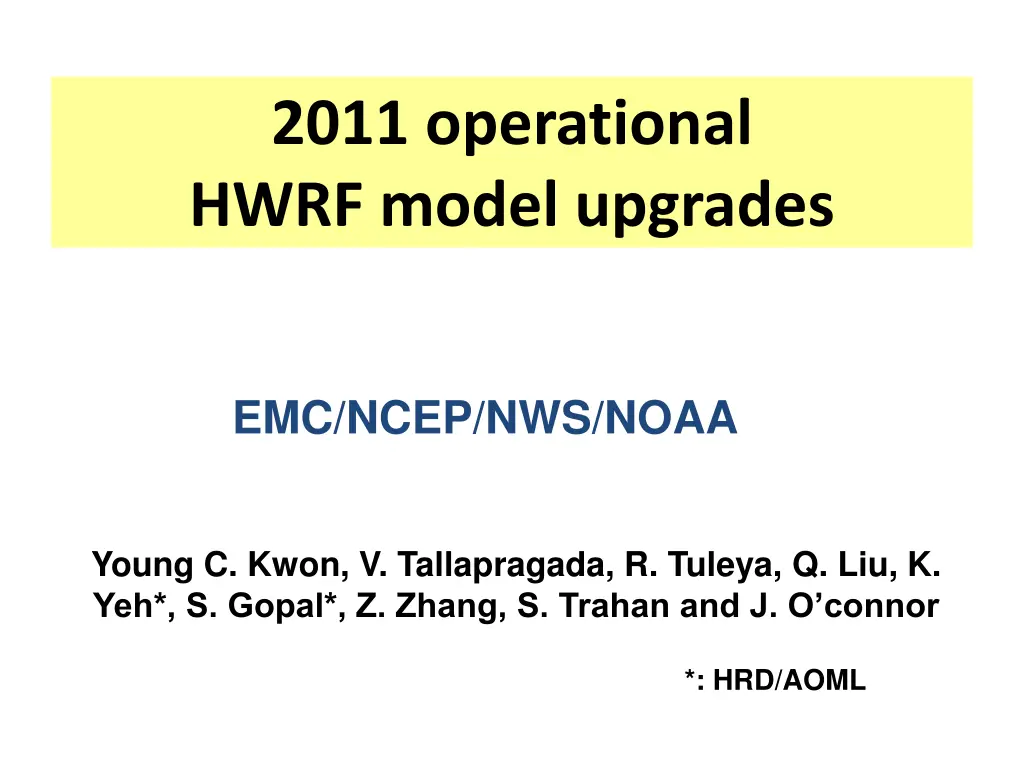
HWRF Model Upgrades - Operational Enhancements for Improved Forecasting
Explore the operational upgrades made to the HWRF model in 2011 by EMC/NCEP/NWS/NOAA. These upgrades include enhancements to core dynamics, vortex initialization schemes, deep convection schemes, and air-sea interaction coefficients. Various experiments demonstrate the impact of these modifications on storm intensity prediction, with significant improvements observed in the model's performance.
Download Presentation

Please find below an Image/Link to download the presentation.
The content on the website is provided AS IS for your information and personal use only. It may not be sold, licensed, or shared on other websites without obtaining consent from the author. If you encounter any issues during the download, it is possible that the publisher has removed the file from their server.
You are allowed to download the files provided on this website for personal or commercial use, subject to the condition that they are used lawfully. All files are the property of their respective owners.
The content on the website is provided AS IS for your information and personal use only. It may not be sold, licensed, or shared on other websites without obtaining consent from the author.
E N D
Presentation Transcript
2011 operational HWRF model upgrades EMC/NCEP/NWS/NOAA Young C. Kwon, V. Tallapragada, R. Tuleya, Q. Liu, K. Yeh*, S. Gopal*, Z. Zhang, S. Trahan and J. O connor *: HRD/AOML
Main components of 2011 upgrades 1. Use WRF-NMM3.2 dynamic core 2. Upgrade the vortex initialization scheme 3. Upgrades of Simplified Arakawa-Schubert (SAS) deep convection scheme to 2010 GFS 4. Modified air-sea enthalpy exchange coefficient (Ch) at high wind speeds 5. Several bug-fixes in radiation and Micro- physics scheme 2
Experiments HR20: Baseline HWRFV3.2 HR21: HR20 + New GFS deep convection HRDI: New Vortex initialization HR28: New Init + New SFC + New deep convection H211: GFS convection + New SFC + New init + bug fixes + new 2011 GFS :: To be run soon
Modified initialization 1. - Instead of matching only RMW but also matching outer radii such as ROCI or R34kt 2. Less use of the composite storms for weak storms - Preventing the rapid spin-up of weak storms 3. Matching the maximum 10m wind speed but not forcing the minimum SLP - With more balanced vortex, rapid spin-down of strong storm is much reduced Vortex size correction * Modified initialization significantly improve the intensity skill of HWRF model (especially 0-48hr)
Baseline Modified initialization improves the intensity skill over 20% at the early time (0-48hr) New INIT
New initialization Initial spin-up for weak storms Much reduced spin-up
New initialization Initial spin-down for strong storms Much reduced spin-down
IGOR 2010091300 HRDI: PARENT HR20: PARENT GFDL: PARENT HR20: NEST HRDI: NEST GFDL: NEST 8
Major changes in deep convection scheme 1. Random cloud top is replaced by a single deep cloud. In sub-cloud layer, entrainment rate is given to be inversely proportional to height and the detrainment rate is set to be a constant as entrainment rate at the cloud base. Above cloud base, an organized entrainment is added, which is a function of environmental relative humidity. 2. Convective overshoot is parameterized in terms of the cloud work function (CWF) (negative energy above neutral buoyancy level is set to be 10% of the CWF). 3. Maximum cloud base mass flux [currently 0.1 kg/(m2s)] is defined for the local Courant-Friedrichs-Lewy (CFL) criterion to be satisfied, but less than 0.5 kg/(m2s). 4. The effect of convection-induced pressure gradient force on cumulus momentum transport is included, which reduce the convective momentum mixing.
Track improved significantly with new GFS convection baseline New convection
New convection However, intensity is too weak with new convection
New init + New init with GFS convection show large negative bias : increase of Ch 12
baseline HR28
Original Ch New Ch 15
Earl Richard BASELINE ~ 35% improvement HR28 Celia Tomas Track degraded
Earl:082800 Earl:082600 Red:baseline Blue:2011 HWRF Celia:062000 Celia:062112
HR28 H211
Red:H211 Purple:2010 opr

